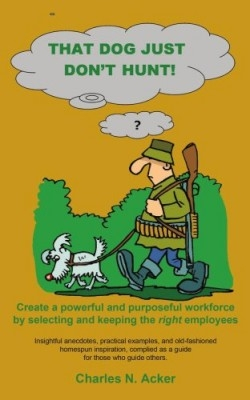That Dog Just Don't Hunt
Create a Powerful and Purposeful Workforce by Selecting and Keeping the Right Employees
As a manager beleaguered with tasks who hasn’t thought that if the employees were only more industrious/dedicated/loyal that business would be better than usual? As an employee coming off an exhausting shift who hasn’t heard the management complain that if they weren’t such lazy bums business would be better than usual? Charles N. Acker in his slim guide to better business answers these employee problems which he says more often than not are management problems.
The title for the book That Dog Just Don’t Hunt comes from the old hunter gripe that blaims the servant for the master’s woes. Just like the hapless employees Acker says that suffer the failures of their bosses. So how does this happen? More than likely the problem begins in muddle. Business owners don’t clarify what they want—besides making money—so managers don’t know what to expect of their employees. “In general employees need to feel useful and that their efforts contribute to the organization. That of course means that the company must also have clearly defined goals a plan to improve and ways to measure that improvement…. This calls first for the business to be clear on where they want to go and what they’d like to achieve…”
Acker began putting his book together on a plane to Fairbanks on the way to the firing a middle manager. He began to ask questions about not only what the manager did wrong but what the manager’s boss did wrong. The result is productive techniques anecdotes cartoons graphs specific examples that lead the reader through six different Big Ideas discovered on that plane ride. Acker believes that the way to help employees and business succeed is by adapting a manager/employee growth relationship.
In this time of top-heavy corporate growth when the CEOs and the shareholders take home the lion’s share and the employees are left with crumbs Acker maintains that “[t]he company has to continue growing its human resource as it grows itself. Otherwise the sustainability of corporate growth will fail because the employees do not keep up with the growth trend resulting in turnover and dissatisfaction among the ranks.”
Big Idea 1 then is titled Natural Ability and includes information about how to align natural talent with the right job. It also gives directions on how to find that talent: how to write an ad; recruitment; and some telling interview questions.
In the first of many great segues between chapters Big Idea 1 leads naturally to Big Idea 2: Training and Education. Big Idea 3 uses a “smelly dog theory” to talk about supervision and it brings up the enormous question of employee loyalty. “I often find that money doesn’t dictate a greener pasture for the employee. It’s more frequently a negative work environment that prompts them to look elsewhere…. Donuts and soda can only do so much to entice an employee’s loyalty.”
The challenge of management says Acker is to carefully select people for their natural talents then mold them into employees who meet expectations. This little book is full of big ideas on how to do just that. A must for every business large and small.
Reviewed by
Heather Shaw
Disclosure: This article is not an endorsement, but a review. The publisher of this book provided free copies of the book and paid a small fee to have their book reviewed by a professional reviewer. Foreword Reviews and Clarion Reviews make no guarantee that the publisher will receive a positive review. Foreword Magazine, Inc. is disclosing this in accordance with the Federal Trade Commission’s 16 CFR, Part 255.

